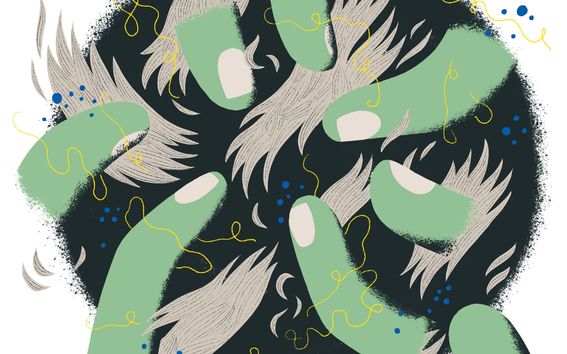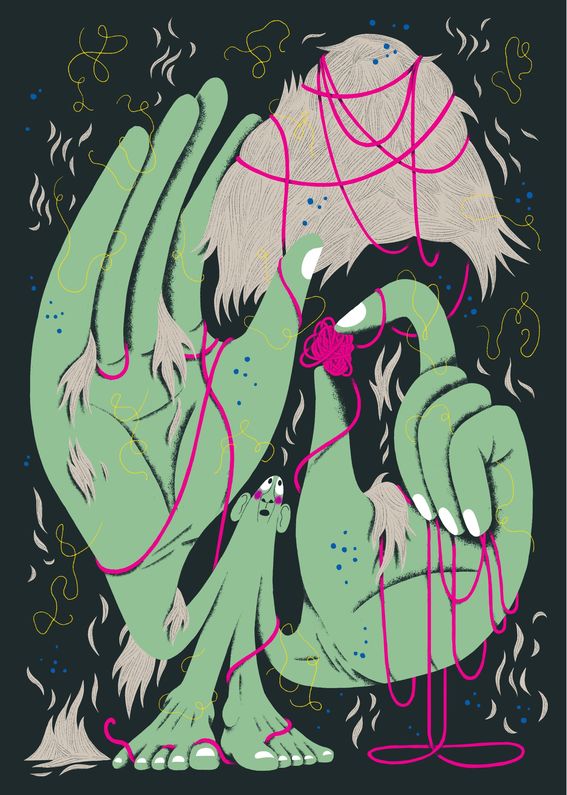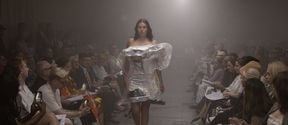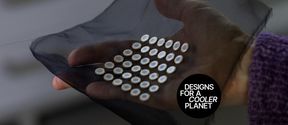‘Materials shape our understanding of the environment’
Dissertation of the Month: Bilge Aktaş believes that if we start paying more attention to what happens in the world beyond humans, we can start repairing our relationship with the environment.

Before we even begin our interview, Department of Design Postdoctoral Researcher and lecturer, designer Bilge Merve Aktaș puts an enormous amount of sheep wool on the table.
She spreads carded wool, felted wool and individual tufts across the table. A few loose hairs waft over the tabletop carried by the flowing air.
Aktaș hands me a pile of untreated wool, telling me it came from Finnish sheep. The wool is still unwashed, dirty.
‘Touch it. How does it feel?’
This first thing I notice is the greasiness of the wool. There’s something familiar about it, my hands are covered by a sticky film, but I immediately find myself sniffing the tuft: its smell transports me to the countryside, to a summer day surrounded by hay.
My reaction is by no means unique. When the students attending the Human-Material Interaction course steered by Aktaș and Camilla Groth reflected on their encounters with various materials, almost all of them commented on scent. The smell of a natural material cannot be ignored. Just think about raw timber.
Furthermore, almost every student compared the sensations the materials brought about to some everyday matter relevant to their own life. For one, working with clay brought to mind days on the beach, while wool reminded others of their grandparents.
Materials give rise to memories of earlier life, prior learning, in all of us.

In Aktaș' and Groth's course, participants have focused on working with clay and sheep wool. As the course is aimed at all Aalto University students, it has instructed business administration, chemistry and IT students alike to grab materials with their bare hands and experiment freely.
The majority of participants have, due to their educational background, a positivist approach to research – end results must be achieved through utilisation of a strict scientific method.
‘In the beginning, the students usually want to know what we’re doing, why we’re doing it and towards what end result. They ask what tangible benefit will this course yield them,’ Aktaș says.
As an educator, she strives to shake up preconceptions. On the course, chemists do not examine clay with a microscope.
‘I often say: don’t think about the end result. Concentrate on what the material is telling you. Feel it and follow it.’
And thus a Lithuanian exchange student’s coursework turned into rolling a small tuft of wool between their hands. The material led them to pause in a near-meditative moment. Another participant refused to felt the wool; for them, uncarded wool was such a wild element that they refused to felt it, it would have been too much like subjugating the material.
One student from the Department of Media would have preferred to only hug the wool – but did eventually make an enormous, blanket-like outfit that covers the entire body.
‘Often when a person approaches a specific material, their mind already holds knowledge and many preconceptions. In the case of wool, I might consider its lanolin content or sheep as farm animals. Thus it can easily happen that you fail to notice all of the tactile, touch-derived information the material is giving away.’
But why on earth should you actually stick your hands in the dirt? Why is it so important to touch materials?
Bilge Aktaș pauses to think before replying.
‘Materials, and especially the experiences we gain through touch, can be shared with everyone. There’s lots of potential for communication and shared experiences there. You yourself are currently in touch with the clothes you’re wearing,’ she nods from across the table.
Aktaș also thinks that the experiences derived from touch provide an excellent avenue for opening a discussion.
‘Even though I myself might not be able to talk about information technology, an IT expert can experiment with and talk about what touching wool feels like. Working with your hands, the information touch and other sense yield opens up possibilities for a new kind of dialogue with your own self as well as with materials, other people and the whole world.’
As an example, Bilge Aktaș tells me about a student who had a strong background in materials research. Even though they had, as part of their basic studies, worked in a lab researching and precisely measuring materials, their experience of processing a material manually was minimal. The student worked with clay on the course and noticed that pottery always requires water as well.
But what about the looming global shortage of clean water?
The student started developing a hybrid liquid that would enable the working of clay also when there was no clean water.
‘This is an excellent example of how a student’s prior knowledge started to engage the material at hand in a dialogue.’
In her doctoral thesis Entangled Fibres: an examination of human-material interaction (2020), Aktaș examined materials as an inseparable aspect of humanity’s everyday experience. Approaching the subject through sheep wool and felting, Aktaș found drawing diagrams and charts via a software to depict the research process sufficiently well as a particularly difficult part of the dissertation process.
She solved this conundrum by felting.
‘I created my visual material out of wool. Once this was done, I drafted new diagrams. Clarifying the matter to myself through felting opened up a fresh perspective on my study, even to myself.’
Aktaș says working with wool forces you to think differently than when working with a pen, for example. You can’t draw straight lines when felting.
‘Different kinds of materials and working them by hand can, in a sense, provide the maker with a new language. We get to express things that are beyond the reach of words.’
Bilge Aktaș has also studied industrial design.
‘I assert that designers who work in close contact with their materials understand and observe them very differently from designers who do everything on computers. Touching a material with your own hands yields a huge amount of information.’
So, what knowledge do we gain from rolling the wool on the table in our hands?
‘Some researchers talk of muscle memory, but to me, touching a material is something much more than that. It is a multisensorial and multidimensional experience packed full of information.’
Touching wool might bring to mind the earlier times you did so. This is accompanied by smell, and sound – rubbing wool produces a sound. Your mind may wander to places where you have used wool, or you might recall that childhood sweater that itched so annoyingly.
‘Or you may start to think of the specific sheep from which the wool was sheared. Among the very wool on the table right now you can spot some straws,’ says Aktaș.
‘Wool is a part of a sheep’s history, a memory of the meadow on which the animal once roamed.’
English has an expression about sticking your hands in the dirt. In this case, my hands dive into light-grey sheep wool, and examining it reveals that each hair is one of a kind.
‘Every sheep grows unique hair. One’s hair is thicker, another’s thin.’
Working with material manually is slow. And it requires repetition, which makes the process even calmer.
‘The material requires attention, it forces you to slow down and focus on the moment.’
Bilge Aktaș recounts another example from her own life. One stressful research project had her working on a loom.
‘Repeating the same movement over and over calmed me down. Since the materials were catching all my attention and I was letting myself be with the material. I started to think about other things in pace with the weaving, more peacefully than before.’
Doctor of Arts Bilge Merve Aktaş is currently working as a postdoctoral researcher and teacher at the School of Arts, Design and Architecture. She is a member of the multidisciplinary Empirica research group, whose topics include art, design and culture. Group approaches research with an attitude, where making, acting and engaging play important roles.
This article has been published in the Aalto University Magazine issue 30 (issuu.com), April 2022.
Go to the Aalto University Magazine page
Text: Tiiu Pohjolainen
Illustration: Tuomas Kärkkäinen
Dissertation of the Month: Bilge Aktaş believes that if we start paying more attention to what happens in the world beyond humans, we can start repairing our relationship with the environment.



